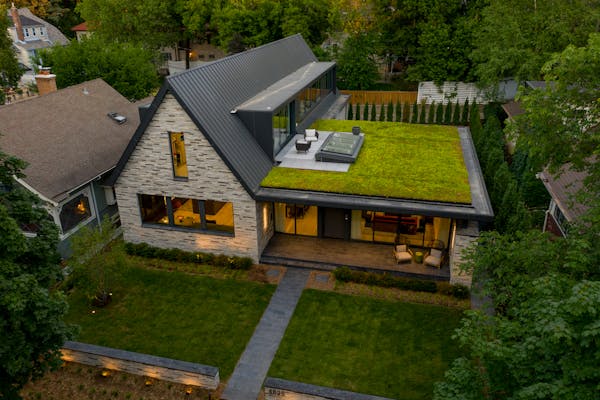This summer, David Schiller, co-owner of Paragon Designs construction and landscaping, put a house on the market in Minneapolis that was as unique as it was eye-catching. The three-bedroom, two-bath structure had a sleek modern design, picture windows and two balconies that suggested cantilevers.
And it attracted media attention — and offers — because of one feature. The 1,300-square-foot house was fashioned from five shipping containers — four 40-footers and one 20-footer. It hit some sweet spots, being a small house built from sustainable, upcycled materials. And during a time of rising home prices, the $280,000 asking price seemed relatively affordable. The home quickly sold.
"It's a way to deal with the housing shortage and with climate change and many issues at once," Schiller said.
For years, shipping containers that are used to ferry manufactured goods from China and elsewhere have been deployed as offices, trailers, studios and cabins. But it's rarer for them to be adapted and fashioned into primary residences in Minnesota.
Schiller, who says that his Minneapolis house is a first, hopes to change that. He first got the idea after he heard about a shipping container house from a friend, who asked if he knew of any in Minnesota.
"That lit a fire in me," Schiller said. "I said, 'Well, why don't we take a look at that.'"
When he asked around, he found that municipal building safety officials raised eyebrows at the idea.
"Bureaucracy," he said. "There was negative kickback from some municipalities about building with containers. That's because the people who had been approaching them before didn't do the research or have the right team."
His research was mostly conducted online. He contacted people in other states who had worked with containers. His pitch highlighted a number of pluses for structures that have solid steel walls.
"If you're gonna reside in it, the walls are airtight," Schiller said. "Durability and strength are also huge bonuses. And you're also recycling and upcycling, reusing primary building materials that may not have a use anymore."
Proof of concept
His Minneapolis house is proof of concept. The business model is sustainable, he said, and a way to be responsible going forward. When Schiller first started looking into the idea, he got excited by the number of containers available.
"It's my understanding that, at some point, because of the trade imbalance between America and China, it was deemed more economical to build the containers in China, fill them with goods and ship them to America, and instead of shipping empty containers back to China, just build new ones there," Schiller said. "Meanwhile, containers are piling up in America. That was highly influential in my decision to pursue this in 2017."
He was in college at the time. Two years later, he graduated and got his builder's license. "But I'd never built a house from the ground up, so I still had to convince investors," Schiller recalled. He bought a single shipping container and renovated it to show people a small-scale version of his vision.
"I wanted it to be energy conscious," Schiller said. "It's 100 percent electric, instead of using gas, which is a finite resource. Electricity is infinite and comparatively cleaner. Throw solar panels on it and it's a net-zero home. That's what I will be building in the future."
Schiller is part of a larger movement of people who use shipping containers. There are websites and blogs dedicated to them. And there are architects who specialize in converting containers into something more.
Larger movement
Minneapolis artist and architect Shane Schaaf has developed a specialty in the area. His Blackbox Container Studios, a five-year-old company, builds structures using containers across the country. He has a brewery project in North Dakota and homes in Colorado and Wisconsin.
"There's probably 10,000 homebuilders in Minnesota building hundreds of thousands of homes now, but there's only a small niche of companies working with containers," Schaaf said, rattling off the upsides. "So there's originality, uniqueness. Another huge factor is sustainability."
Working with containers presents special challenges. To avoid the residue of what might have been transported in the container or the pesticides used to ward off rodents, Schaaf uses only single-use containers.
Insulation also is key. Schiller used foam for his house to address the broad fluctuations in temperature that Minnesotans experience from summer to winter.
"You can't modify the containers too much without compromising structural integrity," Schiller said.
He lists the metalwork and structural work as also challenging.
"It's a new building material with different load capacities and that requires different tools," Schiller said. "Time-wise, it's faster than conventional construction. This took five months to build."
He purchases containers from a third-party vendor, and stores them at a railroad yard in northeast Minneapolis for a daily fee. "It's a yard full of shipping containers stacked 60 feet into the air," he said.
Before the pandemic, you would see them all over the place for storage solutions, especially in the construction industry, where they stash equipment or are used for offices, and are moved from job site to job site. They are also used for cabins.
Now, as the nation comes out of its worst health crisis in a century, Schiller is hoping that building container homes as primary residences will catch on.
"We have five, 10 projects lined up and ready to go," he said. "This is the way of the future."
